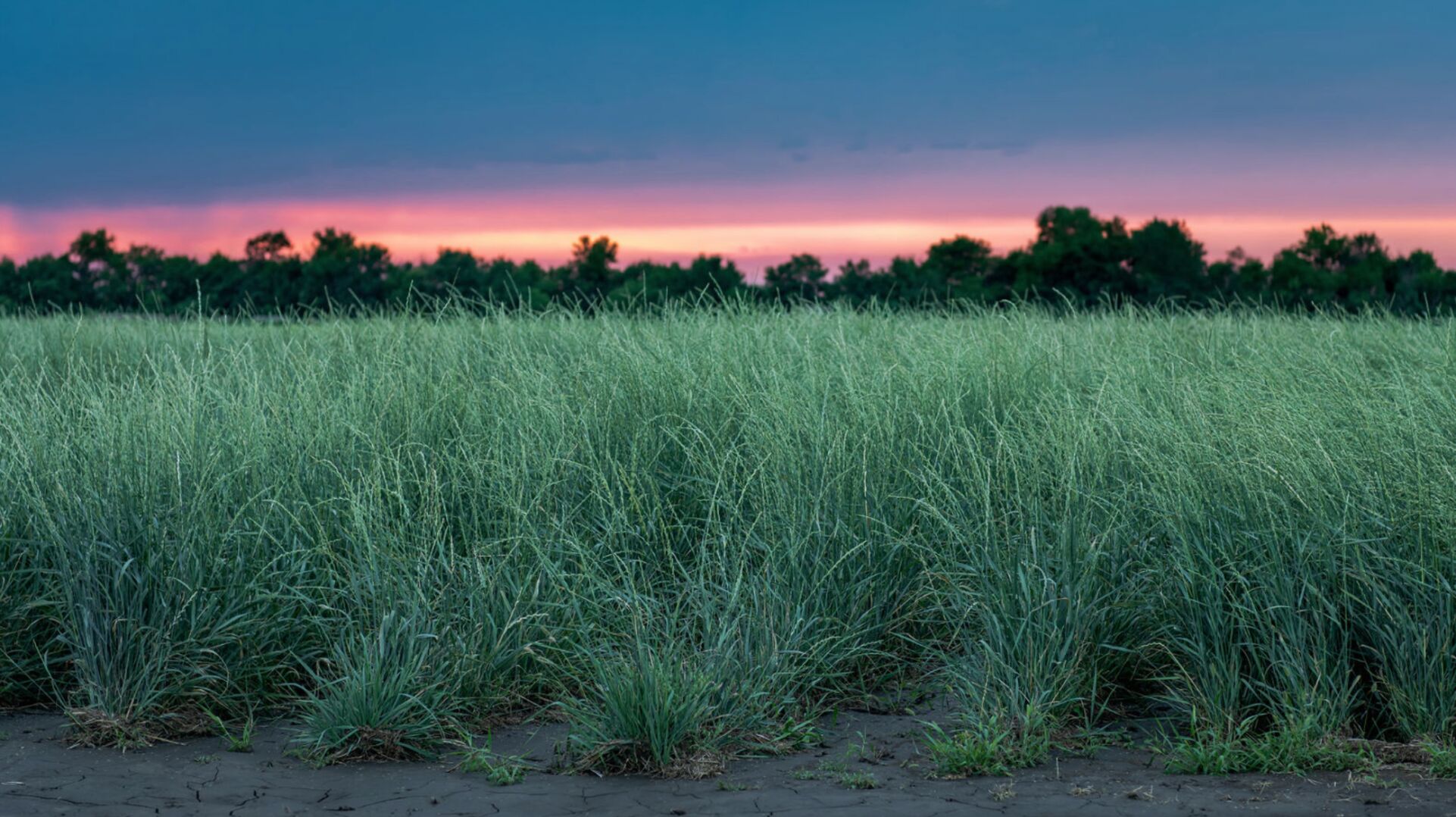No one appreciates nature’s timelines better than Lee DeHaan, director of crop improvement and the lead scientist for the Kernza domestication program at The Land Institute in Salina, Kansas. Kernza is the trademarked name for a variety of perennial intermediate wheatgrass (Thinopyrum intermedium) originally selected by The Rodale Institute.
“There are no quick fixes; solutions are going to take time,” DeHaan told High Plains Journal. “They are only worth investing in for the long term.” He is spending what will probably be his entire career on this single project, directing the project’s many activities from Salina, collaborating with a variety of academic researchers and farmers. He began studying it in 2003.
Kernza sprang from the vision of Wes Jackson, the colorful and controversial farmer, writer and godfather of the sustainable agriculture movement whose books on soil health challenge the way conventional agriculture has been practiced. Jackson was a professor of biology at Kansas Wesleyan.
In his 1980 book New Roots for Agriculture, Jackson wrote, “This book calls essentially all till agriculture, almost from the beginning, into question, not because sustainable till agriculture can’t be practiced, but because it isn’t and hasn’t been, except in small pockets scattered across the globe.” He has received a MacArthur genius grant and helped established the environmental studies program at California State University in Sacramento, California, where he became a full professor
The Kernza project is part of the development of Jackson’s vision of perennial crops that will develop a deep root system like that of original prairie grasses, fixing more carbon, preventing soil erosion and restoring the soil without chemical fertilizers. The Land Institute is also working on perennial legumes, rice, oilseeds and sorghum. DeHaan has explained in interviews how it was his dream from childhood to work on perennial crops, and Jackson’s Land Institute was the only place where that was possible. Kernza wheatgrass can be easily harvested using conventional combines, according to DeHaan. It yields a seed that is, so far, smaller than conventional wheat kernels but can be ground to a flour that can easily be blended with other flours and reportedly has a distinctive nutty, appealing flavor.
DeHaan is currently working on increasing yields and seed size and figuring out the best places to grow it. The species has had all its genes sequenced, said DeHaan. “Many of the genes we are interested in are already well understood.” The website speaks of different varieties being developed for different climatic regions.
Kernza is not lacking for friends and advocates. It’s been 10 years since the trademark was filed. According to The Land Institute’s website, there are currently 107 farmers producing it on more than 2,000 acres globally. Kernza grain has already found commercial uses, albeit in small niche venues. Ingredient producers, millers, and distributors “are moving Kernza grain from farm to market, and consumers are enjoying Kernza in products and menu items across the U.S.”
The outdoor outfitter Patagonia has introduced a pale ale called “Long Root” made from Kernza grains, and some specialty bakers have used and touted Kernza flour in their products. Patagonia founder Yvon Chouinard has called the Kernza project “the most important experiment” the company has ever tried. General Mills has helped fund Kernza development through the Forever Green program at the University of Minnesota.
All this gets back to the question of nature’s timelines. In a 2015 article, DeHaan said that perennial grain research was not attracting the attention or resources that other, less promising and less transformative research efforts were. But in 2010, he had predicted that it wouldn’t be ready for farmers to grow for 10 years; it happened in three years instead. Now demand may be outpacing supply.
Today, DeHaan accepts that Kernza cultivation must fit into a system where farmers need to be profitable. Committing to a perennial crop is a longer term risk. You’re operating more like an orchard grower, who may not see positive returns for years, than a conventional row-crop farmer who can switch crops from year to year in response to price fluctuations. On the website, he says, “[Y]ou can’t just expect you’re going to get some seed, plant it, and make money next year. If you’re a grower, you’re signing up to participate in the ongoing discovery of how we’re going to grow this crop.”
In some years, DeHaan says, a field full of Kernza may be more valuable as forage or a biofuel crop than a food crop. “At this point it’s much better to see it as a forage crop that you also take grain from in certain situations. That is a challenge for everyone, including the supply chain and buyers, to not have as certain of a grain harvest for every acre that you plant. People like to think you can plant 100 acres to get this many bushels and rely on it very dependably. It’s not that way, at least not yet.”
Carbon benefits
But what about all those carbon sequestration benefits? The past few years have seen greatly increased interest in the question of ag carbon credits.
Soil carbon sequestration is influenced by a wide array of factors, including climate and soil type, said DeHaan. Estimates of carbon sequestration in farm fields vary widely, but in general perennial grasses, which built the rich prairie soils, are expected to have outstanding carbon sequestration potential. Modeling work is being done to incorporate Kernza into the COMET-farm carbon-accounting method. Integration into this accounting model will make the crop attractive to organizations such as the NORI “private carbon-removal marketplace,” which offers $15 per ton of carbon removed in agricultural fields.
But as a recent webinar by the Purdue Center for Commercial Agriculture recently made clear, it’s far from certain whether, and how soon, a sustainably viable system of carbon payments to farmers can happen. The problem is measurements, making carbon results—and therefore carbon credits—fungible across multiple crops, regions and agricultural practices. Right now, according to Carson Reeling, assistant professor of agricultural economics at Purdue, “we’re really not sure what we’re measuring.”
Most carbon credit systems are operated by private markets in which companies use various systems of measurement. While some sampling of fields and results is involved, the samples are used to generate computer models that estimate the amount of carbon sequestered by a particular crop, in a particular region, using particular practices. This variability of measurement and computer estimation makes carbon credits in these markets essentially a form of private cryptocurrency.
For carbon markets to stabilize and become truly viable, suggests Jim Mintert, director of the Purdue Center for Commercial Agriculture, government may have to become involved in setting standardized measurements and fostering information transparency, just as the U.S. Department of Agriculture already does with other types of agricultural information.
If the amount of yield per acre of Kernza varies according to region, climate and rainfall, surely the same would be true of the amount of carbon sequestered. This is an issue for all agricultural carbon measurement systems, not just that of Kernza. So while carbon payments may be part of the picture, as with other crops, they cannot drive commercialization of Kernza.
Sign up for HPJ Insights
Our weekly newsletter delivers the latest news straight to your inbox including breaking news, our exclusive columns and much more.
Now, DeHaan is talking about full commercialization within another 10 years. “Hopefully, in 10 years a farmer will be able to buy seed from a normal seed outlet. Or maybe that won’t be the model. Maybe it will be a contract and farmers are given the seed and then grow it. Nevertheless, the idea is that the system will work as a market with the availability of grain and the price being set based on what the supply is that year. But everyone must collaborate and understand that we don’t yet really have a fully viable crop, we don’t really have a market–that’s where we’re heading to.”
David Murray can be reached at [email protected].




